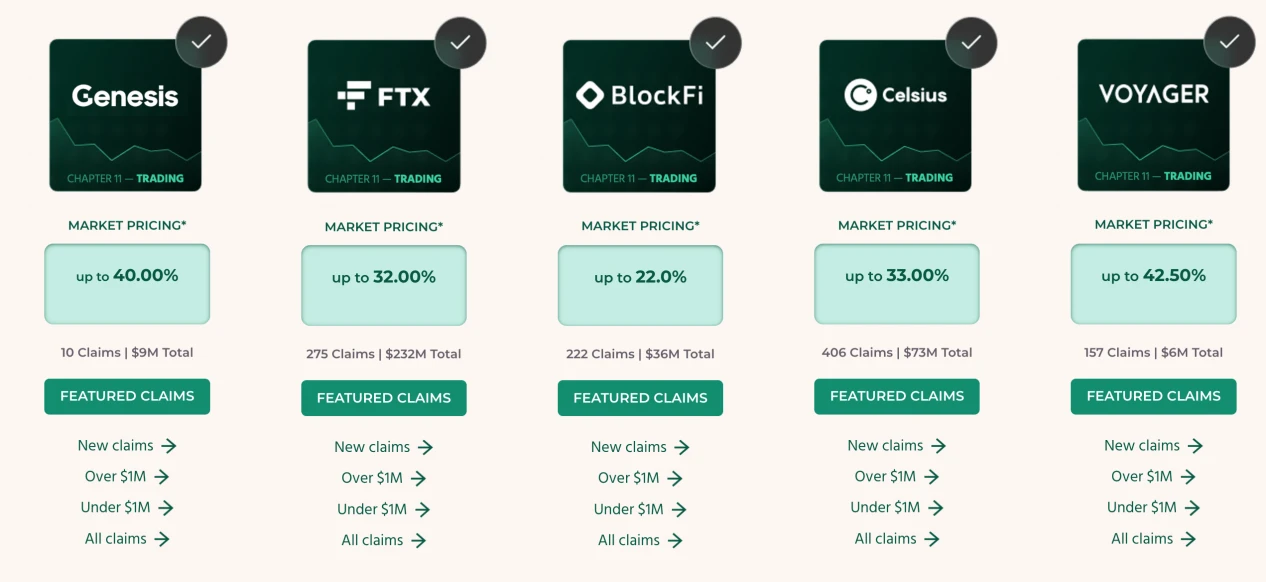Is the tokenization model of crypto asset debt rights difficult to sustain? Behind it lies the unresolved debt issue of Web3
Author: DeMan
OPNX, formerly known as GTX, is a new type of exchange launched by Su Zhu and Kyle Davies, founders of Three Arrows Capital, along with Mark Lamb, co-founder of CoinFLEX. Its core innovation lies in supporting the tokenization of bankruptcy claims. Through this approach, OPNX aims to simplify the claims process, create a public market for trading bankruptcy claims, and facilitate the release of trapped capital.

Despite initial challenges, such as the suspension of withdrawals by CoinFLEX in 2022 leading to a crash in the price of Flex tokens, OPNX has found its footing in the market. At the beginning of 2023, with financing news for GTX, the Flex token experienced a revival, with prices rising to $2.8 at one point. However, when OPNX officially launched in early April 2023, the business data was not ideal, with only two transactions on the first day and a significant drop in the price of Flex tokens.
In June 2023, with the launch of OX and the synergistic effects of FLEX, OPNX began to gradually recover and carve out a place in the market. Since June, its trading volume and market capitalization have seen significant growth, reaching nearly $700 million in total market capitalization by June last year, surpassing several well-known exchanges.

Overall, the rise of OPNX demonstrates the dynamic changes in the cryptocurrency market and the importance of innovation. Despite facing challenges in its early stages, OPNX has gradually established its position in the cryptocurrency trading field with its unique business model. The following provides an overview of this project and its gameplay.
Burdened by CoinFLEX's Legacy Issues, OPNX Faces a Difficult Start and Continuous Challenges
OPNX has experienced a series of challenges and responses in the cryptocurrency market. Initially part of GTX, and later renamed OPNX, this platform aims to innovate the way cryptocurrency trading is conducted, but its journey has not been smooth. Because this exchange has the genes of CoinFLEX, many of the historical legacy issues of the latter have been reluctantly inherited by OPNX, making its development journey fraught with difficulties.
CoinFLEX's liquidity crisis and subsequent compensation plan marked an important turning point in the industry, particularly with the issuance of rvUSD. Although aimed at alleviating the crisis, its market performance did not meet expectations. As of August 2022, rvUSD was priced at only $0.15 on OPNX, with no trading volume, which clearly hindered the OPNX project.
The restructuring plan of CoinFLEX received broad support from creditors, indicating a certain level of market confidence in CoinFLEX's future. After the restructuring, creditors received 65% of the company's shares, while the CoinFLEX team was allocated 15%.
After selling shares, the CoinFLEX team had a breather and began investing in 2023. On January 16, Su Zhu and Kyle Davies, along with CoinFLEX, planned to raise $25 million for the new cryptocurrency exchange GTX (which is OPNX). However, OPNX's performance in the market differed from expectations. When OPNX officially launched in April 2023, it completed only two transactions on its first day, with a total trading volume of just $1.26.
In response, OPNX launched a market maker program aimed at increasing market activity, but faced challenges in investor relations. In April 2023, OPNX claimed to have investments from several well-known institutions, but subsequently, some institutions denied investing in OPNX. This may have affected market confidence in OPNX.
Despite the challenges, OPNX continues to explore new market strategies. For example, partnerships with Heimdall, the introduction of the governance token OX, the launch of debt trading features, and the introduction of Justice Token. Particularly, Justice Token, although defined as a meme token, showcases OPNX's diversity in product design.
OPNX's launch of oUSD and Launchpad projects, such as the unsecured credit market Raiser and Gameplan, aims to increase user engagement and market influence. However, the market acceptance and effectiveness of these projects remain to be observed.
In summary, OPNX's development journey reflects the uncertainty and complexity of the cryptocurrency market. From the crisis of CoinFLEX to the launch of OPNX, and the adjustment of market strategies, OPNX's journey embodies the challenges and responses in a dynamic market environment. Although its future development remains uncertain, OPNX's efforts provide new perspectives and references for the development of the cryptocurrency industry.
Despite its numerous flaws, OPNX does not hinder investors from understanding its tokenomics model.
In exploring the operation and influence of the OPNX platform, its platform token $OX plays a key role. The supply and utility mechanism of $OX are crucial for understanding the platform's operation.

The total supply of $OX is closely related to $FLEX, determined by the following formula:
Total Supply = ($FLEX Total Supply - Number of $FLEX Burned) * 100. For example, based on current data, the supply of 986 million $OX is calculated from 100 million $FLEX minus approximately 1.4 million $FLEX burned, then multiplied by 100.
This calculation directly links the supply of $OX to the market performance of $FLEX. Below is a detailed introduction to the $OX mechanism.
Transaction Fee Rebate Mechanism: Users can reduce transaction fees by staking $OX. When the amount of $OX staked is equal to or greater than the user's OPNX trading volume, they can enjoy a 100% rebate on transaction fees; for the portion of staked amount exceeding trading volume, a 50% rebate is provided; all rebates are paid in $OX.
Transaction Fee Discount: Even if users do not stake $OX, they can still enjoy up to a 50% discount on transaction fees.
Additional Rewards and Incentives: Staking $OX also earns airdrop rewards for OPNX Launchpad and Justice Tokens; $OX can also be used as collateral for futures trading, reducing costs associated with the tokenization of physical assets.
Conversion Mechanism between $FLEX and $OX: $FLEX can be converted to $OX at a ratio of 1:100. If users choose to lock up their tokens for three months during conversion, they can enjoy a preferential exchange ratio of 1:125 until August 28, 2023. Currently, about 35% of $FLEX has been converted to $OX. Since this is a one-way conversion mechanism, the theoretical price ratio of FLEX to OX should be 100:1. When the price of FLEX is below this ratio, converting to OX serves as a stabilizing mechanism. Conversely, when the price of FLEX is above this ratio, the inability to convert OX back to FLEX limits arbitrage opportunities.

Overall, the design of the $OX token on the OPNX platform not only influences traders' behavior but also significantly impacts the platform's liquidity and market positioning. Through these mechanisms, OPNX aims to create a reciprocal ecosystem that promotes trading activities while maintaining value balance between tokens.
Although OPNX's Future is Uncertain, Its Innovative Gameplay Can Provide Valuable References for the Industry
OPNX's development path reflects the significant gap between ideals and reality in the cryptocurrency field. As a platform that is theoretically innovative, its integrity and comprehensiveness in the field of debt trading are undoubtedly a highlight in the market. However, when these concepts meet the actual demands and reactions of the market, OPNX faces numerous challenges.
The low trading volume of tokenized debt and the lukewarm response to significant initiatives such as FTX claims reveal a deeper issue: the market's limited acceptance of such innovations. This is not merely a liquidity or market perception issue, but also broadly involves investor confidence and market maturity. Furthermore, while OPNX strives to stimulate the market through frequent launches of new features and positive news, the quality issues of its launchpad projects and critical market feedback further highlight its challenges in product development and market positioning.
Amid these operational difficulties, the high premium of the OX token reflects a market optimism about OPNX's future potential. While this expectation has its positive aspects, it may also pose risks, especially in the current market environment, where any unmet expectations could lead to a reassessment of its value.
As a cryptocurrency trading platform, OPNX faces multifaceted challenges, including market acceptance, product quality, and the rationality of its valuation. In the future, how OPNX addresses these challenges and adjusts its strategies to better adapt to the market will be key.










